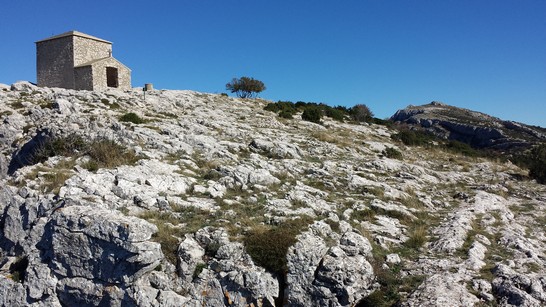
PLAN D’AUPS SAINTE-BAUME - Saint-Pilon Chapel
Entering the Sainte-Baume forest is like stepping into a fable. The coolness, shade, tall trees, dense vegetation and singing birds transport you to a fairy-tale ambiance and accompany you along the path to Mary Magdalene's cave. Take in the superb scenery of Sainte-Victoire and the Plan-d'Aups plain. As you climb up the mountain ridges, a 360° panoramic view scans the horizon, from the Mediterranean Sea to the Alps.
10 points of interest

Forêt d'exception  Flora
FloraForêt d'exception®
In September 2018, the Sainte-Baume forest obtained the Forêt d’Exception® label, which recognises national forests for the quality of their management and their unique heritage in terms of biodiversity, landscapes, history or high-value timber. This 2076 ha forest contains 130 ha that are part of the relic beech forest. Associated with Mary Magdalene’s cave, the site is a popular destination within the park, which welcomes almost 500,000 visitors per year.

L'obélisque des compagnons sur le chemin du Canapé - Stéphanie Singh - PNR Sainte-Baume  Patrimony and history
Patrimony and historyL'obélisque des Compagnons
As legend has it, Sainte-Baume houses the tomb of Maître Jacques, who together with Père Soubise and King Solomon, is considered one of the founders of the Compagnons du Devoir Companionship. This worker movement, based on the transmission of knowledge and solidarity between its members, helps apprentices continuously progress. It was in the Middle Ages that the Companionship became organised and introduced the Tour de France, a period of mobile training ending with a then-mandatory stint in Sainte-Baume.
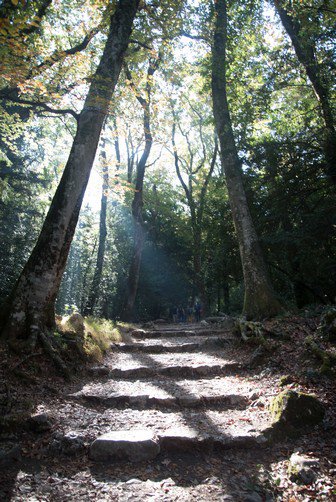
La forêt relique - M. Desbief  Flora
FloraThe “relic” forest
The Sainte-Baume beech forest, located at the base of the cliff, is home to vegetation that has disappeared from many places in Provence. Its history related to the sacred, and its exceptional nature, led it to be called a “relic forest”. It is of great natural value on account of the number of remarkable trees (white oak, linden, Italian maple, yew, holly) and the 200- to 300-year-old beech trees it contains, and due to the high biodiversity of its undergrowth.
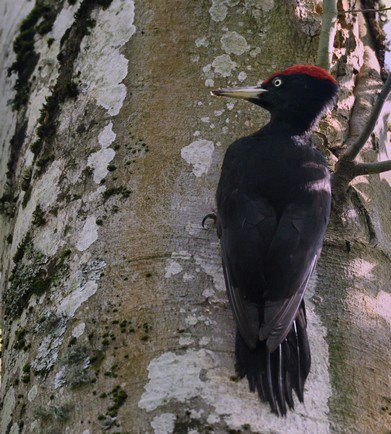
Le pic noir - J.C Tempier - CEN PACA  Fauna
FaunaBlack woodpecker
The black woodpecker is the largest woodpecker in Europe. Its wood-hammering capacities make it an essential link in the forest ecosystem. The nesting chambers it creates in tree trunks provide comfortable homes for numerous invertebrates, birds and mammals. Insectivore, it loves ants, larvae and wood-boring insects. With a bit of luck, you may be able to sense its presence near the trail thanks to its drumming or the marks it has left on tree trunks.
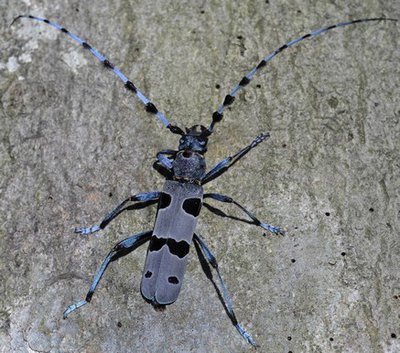
La rosalie des Alpes - J.C Tempier - CEN PACA  Fauna
FaunaDid you say wood-boring insects?
The Wood-boring insects are those that feed on wood. They include an endangered species found in the Sainte-Baume forest: the Rosalia longicorn. Living in larval state in dead beech wood, it turns into a magnificent beetle several years later. Dead wood is scarce in managed and cleared forests. The “soft” management of the Sainte-Baume forest provides shelter for this remarkable species, as well as many others.
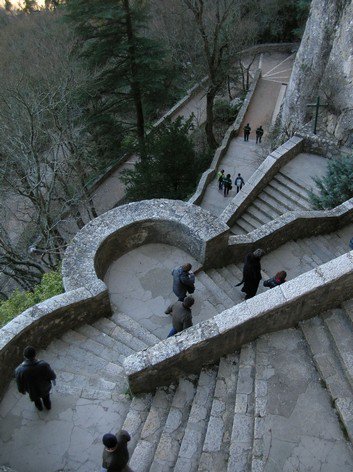
La montée à la grotte de Sainte Marie-Madeleine - Stéphanie Singh - PNR Sainte-Baume  Patrimony and history
Patrimony and historyMary Magdalene's grotto
The Sainte-Baume massif has long been considered sacred. As legend has it, in the 1st century, Mary Magdalene spent the last 30 years of her life there as an ascetic, in a cave that gave the site its name (baumo means ‘cave’ in Provençal). In the 5th century, John Cassian, who contributed to the spread of Christianity in Provence, set up a priory there. It then gradually became a place of pilgrimage, with pilgrims coming to admire the site where Mary Magdalene lived.
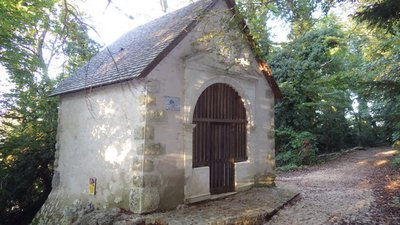
La chapelle des Parisiens sur le chemin des Roys - Jean-Marc Prieur - PNR Sainte-Baume  Patrimony and history
Patrimony and historyChapelle des Parisiens
On the path to the Saint-Pilon pass, you will find Chapelle des Parisiens, also called the “chapel of the dead”. Built in 1636 by Esprit Blanc, general tax inspector, it owes its name to the administrator's “Parisian” residence in Aix-en-Provence. This chapel was restored by the Compagnons du Devoir in 2007.
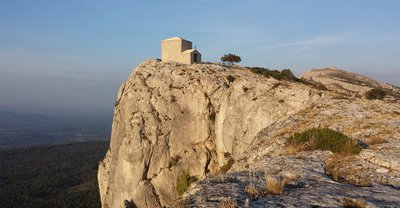
La chapelle de Saint-Pilon - Jean-Marc Prieur - PNR Sainte-Baume  Patrimony and history
Patrimony and historyMary Magdalene's Grotto and Saint-Pilon trail
The Chapelle du Saint-Pilon chapel is thought to have been built in the 14th century on the site of a pillar (from the Provençal pieloun), a stone column onto which, according to Provençal tradition, Mary Magdalene was lifted seven times per day by angels from the cave. Ravaged during the French Revolution, it underwent major restoration work undertaken by a Compagnons du Devoir team between 2015 and 2017. From the chapel, visitors can enjoy a 360° view, from the Mediterranean Sea to the Provençal hinterland.

Un des oratoires du chemin des Roys - Andrea Fernandez - PNR Sainte-Baume  Patrimony and history
Patrimony and historyThe oratories
Places of prayer and reflection, the oratories depict scenes from Mary Magdalene’s life. Built in 1516 at the initiative of Monseigneur Ferrier, Archbishop of Arles, they are currently classified as Historic Monuments. Of the seven initial oratories, six have recently been rehabilitated and only the 7th, at the Col du Saint-Pilon pass, is missing. During this hike, you will pass by the 5th (twice), 6th, 4th and 3rd oratories, in that order.

Les oratoires sur le chemin des Roys - JP Vallorani  Patrimony and history
Patrimony and historyChemin des Roys
This medieval path is associated with the development of the cult of Mary Magdalene. It links Saint-Maximin, where she took her last breath, to the Saint-Pilon chapel. Chemin des Roys opened in 1295, when the Dominican Friars settled in Sainte-Baume. It owes its name to the illustrious figures that took it. Until 1897, when the departmental road was built, this path, lined with seven oratories, was the only way to get from Nans to Sainte-Baume.
Description
With your back to the Sainte-Baume Tourist & Discovery Area, cross the road to the corner of the “Parking de l'Hostellerie Est” (information sign), on your left.
1- Facing the Sainte-Baume mountains, take GR9® (red and white markings) going due south, via the trail leading to the forest. After the wooden bridge, take Allée Royale on your right.
2- At the junction with the Compagnons du Devoir obelisk, start climbing Chemin du Canapé, to your left. At the intersection with Chemin de Giniez (pole), turn left in the direction of Grotte de Sainte Marie-Madeleine (Mary Magdalene's cave) and go past a first oratory.
3- At the “Oratoire” junction (pole), continue the climb on your right until you reach the stairs and then Mary Magdalene's cave. Taking the same route, descend to the Carrefour de l'Oratoire junction. Then start the climb on your right (GR®9). Go past the Chapelle des Parisiens chapel and continue to the Col du Saint-Pilon pass (952 m).
4- Take GR98® on your right and stay on the trail amidst the limestone pavements until you reach the Chapelle du Saint-Pilon chapel. Then take the same route back to the Carrefour de l'Oratoire junction (point 3).
3- Turn right and continue the descent via Chemin des Roys, following the yellow markings. Pass by the Source de Nans spring and stay on the main path.
5- At the Placette des Trois Chênes plot, with your back to the sign, take Allée Royale on the far left to the wooden bridge you took earlier and head back to the starting point.
VARIANT: After visiting the sanctuary of Mary Magdalene's cave, go back down to the Carrefour de l'Oratoire junction (point 3) and continue the descent via Chemin des Roys until you reach the Placette des Trois Chênes plot (point 5) and directly return to the starting point.
- Departure : Sainte-Baume Tourist & Discovery Area, Plan-d'Aups-Sainte-Baume
- Arrival : Plan d'Aups Sainte-Baume
- Towns crossed : Plan-d'Aups-Sainte-Baume and Riboux
Forecast
Altimetric profile
Recommandations
- In the winter (until the daylight-saving time change), from 8:30 am to 5 pm
- In the summer (until the daylight-saving time change), from 7:30 am to 6:30 pm.
This itinerary is a mountain route subject to climate variations. You should avoid the ridge line in the event of rain, wind and/or fog.
In the summer, access to the site is subject to forest access regulations related to the risk of fire. Please check the access conditions for the day on the website of the Var prefecture.
Information desks
Espace Tourisme & Découverte de la Sainte-Baume
Hostellerie de la Sainte-Baume, 83640 Plan d'Aups Sainte-Baume
Parc naturel régional de la Sainte-Baume
Access and parking
Parking :
Access
- Emergency number :
- 114
More information
Source

Report a problem or an error
If you have found an error on this page or if you have noticed any problems during your hike, please report them to us here:


